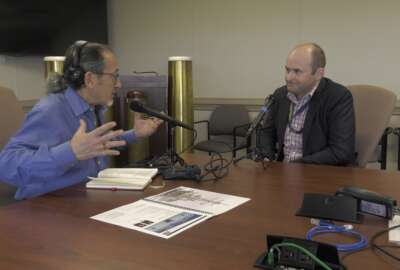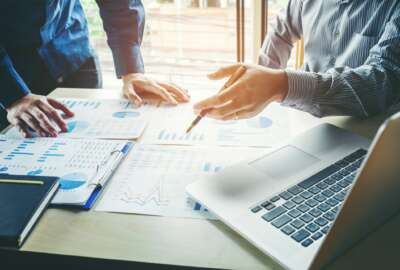
Another agency discovers the benefits of other transaction authority
The Naval Surface Warfare Center Dalhgren Division, like other defense units, seeks to bring new industrial capabilities quickly to benefit the mission. Now it has...
The Naval Surface Warfare Center Dalhgren Division, like other defense units, seeks to bring new industrial capabilities quickly to benefit the mission. Now it has entered into a new other-transaction-agreement, or OTA, to do just that. OTAs in the right circumstances let agencies speed up acquisitions, often non-competitive ones. For details, Federal Drive with Tom Temin spoke with the Dalhgren Division’s Head Contracting Officer, Melisha McAuliffe and with VP of the Sea, Space and Air Division at ATI, Chad Bryant.
Interview transcript:
Tom Temin
And I’m going start with you, Ms. McAuliffe tell us the relationship between Dahlgren and Advance Technology International and how this whole system is set up for Other Transactional Agreement’s and then we’ll get into what it is you’re gonna buy with this.Melisha McAuliffe
Sure. In 2019, the Naval Surface Warfare Center Dahlgren was interested in establishing an OTA. What were looking for a consortium manager. So we solicited and competitively awarded an agreement, other transactional agreement, with ATI being the consortium manager. The partnership with ATI has been phenomenal. NSWC Dahlgren-OTA, is the Naval Surface Technology and Innovation Consortium. ATI currently manages well over 1,000 members, companies, non traditional entities, etc, that are members of this consortium.Tom Temin
OK, and let me ask you Chad, then ATI is a .org. Correct? And how do you operate these consortia, what happens?Chad Bryant
Yes, we are a .org. So ATI, we’ve been in the collaboration management firm business for about a quarter century. So just shy of 25 years. Our business model is essentially to build and lead technology development collaborations. And sometimes, and oftentimes, these collaborations will take the shape of a consortium, such as the Naval Surface Technology Innovation Consortium. And the premise behind what we do is we bring together a diverse mix of technology cohorts, and that includes commercial companies and academic institutions, to help identify technical challenges that government may have, and help provide solutions, which ultimately get to the warfighter.Tom Temin
And Ms. McAuliffe, let’s get an idea of some of the things that you are hoping to acquire in a quick agile manner using the consortium, using the OTA the other transaction authority. What are you looking at taking into Dahlgren?Melisha McAuliffe
A variety of things. So just to give you a little bit detail about the OTA. The Other Transactional Agreement has 22 technology areas, and we within this other transactional agreement, the technology areas allow for supporting cyber requirements, big data analytics and artificial intelligence requirements, unmanned systems, e-cubed requirements, and that is electromagnetic environmental effects and spectrum. So there’s a variety of potential research and development requirements that can be satisfied with this OTA.Tom Temin
And what about hypersonics?Melisha McAuliffe
Hypersonics is on our list as well. As well as lethality, launcher technology, human systems integration, we’re also looking at quantum technology, digital engineering, gun and projectile systems. Again, those are part of the 22 technology areas. So if there is a need, and we’re looking for a solution prototype, then the OTA is the tool to use to try to get to those, again, those mom and pop shops, those nontraditionals that we are not currently aware of or that we currently have not done business with, and they may be able to bring the solution that the Navy needs to complete its mission.Tom Temin
We’re speaking with Missy McAuliffe, she’s contracting chief at the NSWC Dalhlgren Division, and with Chad Bryant, the vice president of the Sea Space and Air Division at ATI, their OTA consortium manager. And let’s just use hypersonics as an example. I like that one, because I actually held in my own hands a hypersonic projectile when I was down at a Dahlgren last year, and thought it was a pretty cool piece of aluminum to be honest with you. Suppose you need something a piece of research or a prototype of a component in a hypersonic system. What’s the process by which the potential vendors, these nontraditional vendors are identified, then how do they interact with the consortium in such a way that they result in some expenditure and developing something for you. How does it all work?Melisha McAuliffe
ATI again, as the consortium manager, they developed a tool in which all of the consortium members have access. So when NSWC Dahlgren technical community has a need, they’ve developed a statement of need. That statement of need is provided to ATI who then submits it or shares it with all of the members of the consortium. Those members have an opportunity to develop a proposal and submit that proposal. Of course, there are timelines associated with that. But the proposals are submitted, the government receives those proposals are able to readily evaluate those proposals, and then are able to move forward with the offeror who offers the ideal solution.Tom Temin
Got it. And Mr. Bryant, it sounds as if ATI maintains almost an ecosystem of small vendors, small companies with capability, I should say, in each of these technology areas.Chad Bryant
Tom, that’s a great way to put it. We actually have each one of these consortia is purpose built around a portfolio of technologies, which equates to essentially building an ecosystem. And inside that ecosystem, we have the large traditional contractors, and we have the preponderance of the ecosystem are small and nontraditional contractors, companies that wouldn’t necessarily work with the federal government in a contract scenario. So we build those individual consortiums to match that portfolio of technology areas such as NSTICS [National Strategy for Trusted Identities in Cyberspace].Tom Temin
Sure, and for the government’s part in using other transaction agreements or OTAs authorities, then you are not doing Federal Acquisition Regulation procurements. So there is a lot less burden a lot less bureaucratic process on the government’s part. Is that also true for the vendors, when coming in through an OTA? There’s less maybe compliance that they have to do than they would if it was a FAR procurement?Chad Bryant
Yes, absolutely. So they’ve got an opportunity that these commercial vendors and these nontraditionals when they come in, they’re not burdened by some of the Federal Acquisition Regulations, such as the accounting systems and some of the other type of systems that will tend to, you know, to kind of slow down the process and also turn away some of these, these smaller vendors. So there’s great opportunity there for them.Tom Temin
And do you have kind of a filtration system such that some really big camels don’t get their nose into the OTA tent, because they’re not really the type of vendors you’re trying to work with?Chad Bryant
We actually work across the spectrum. We do have large traditional contractors and the majority of our consortia. And oftentimes, these traditional contractors may take the lead on individual efforts and prototyping efforts and bring in a nontraditional or commercial entity to assist in what they call to a significantly extent to provide some of the technology they may not have access to. So there is play for both large traditional contractors and the nontraditionals. However, the purpose behind these OTAs are really to reach out to those smaller vendors, as I mentioned earlier, that wouldn’t have normal access or normally would not access the federal space.Tom Temin
So it’s a little different than the traditional teaming or subcontracting arrangements that you would have under a FAR between large companies and small companies?Chad Bryant
Yes, you could say that.Tom Temin
All right. And Missy, give us some results you’ve had so far. Any signature projects you can describe for us?Melisha McAuliffe
Yeah, we were talking about the vendors that actually participate. And again, it’s a mixture of both large small academia etc. But one of the big tickets that’s associated with this OTA is that a nontraditional has to play a significant role in each project. So even if award is made to maybe a larger contractor, the preponderance of the work or the effort needs to be performed significantly by one of those nontraditionals. That being said, to answer your current question, we’ve actually awarded over 50 projects against our OTA executing well over $300 million, just in the last two and a half years from inception. Projects that we’ve executed include a jet gun phase one, a broad ocean area prototype, data collection system, the wave reaper, a commercial-off-the-shelf radar blinker. Again, against all of the 22 technology areas. So there’s a variety of projects that have been executed.Tom Temin
Sure. And as we get into 2023, do you have fresh authority, fresh money coming in? And this will continue? What’s the future look like here?Melisha McAuliffe
Yeah, we have sponsors. We’re currently in an open cycle, where we’re obtaining statement of needs from the technical community. And we’ve been gving a projection that there are a significant number of projects that are anticipated from one of the technical departments here. So we expect that this OTA will continue to grow. It’s becoming more and more popular and useful for our not only in NSWC Dahlgren, but sponsors such as IWS One, Integrated Work Systems at NAVSEA, are using this OTA. We do expect that to continue to expand.Tom Temin
And Chad if someone has a really bright idea and they think they can start a small company, how do they get involved via an ATI?Chad Bryant
If they’re looking to reach out to ATI you can find us on a public website ati.org. Mentioned earlier we have over two dozen collaborations that may be of interest to small businesses and nontraditionals so we just asked to reach out ati.org or you could contact me directly via my LinkedIn.
Copyright © 2025 Federal News Network. All rights reserved. This website is not intended for users located within the European Economic Area.
Tom Temin is host of the Federal Drive and has been providing insight on federal technology and management issues for more than 30 years.
Follow @tteminWFED





